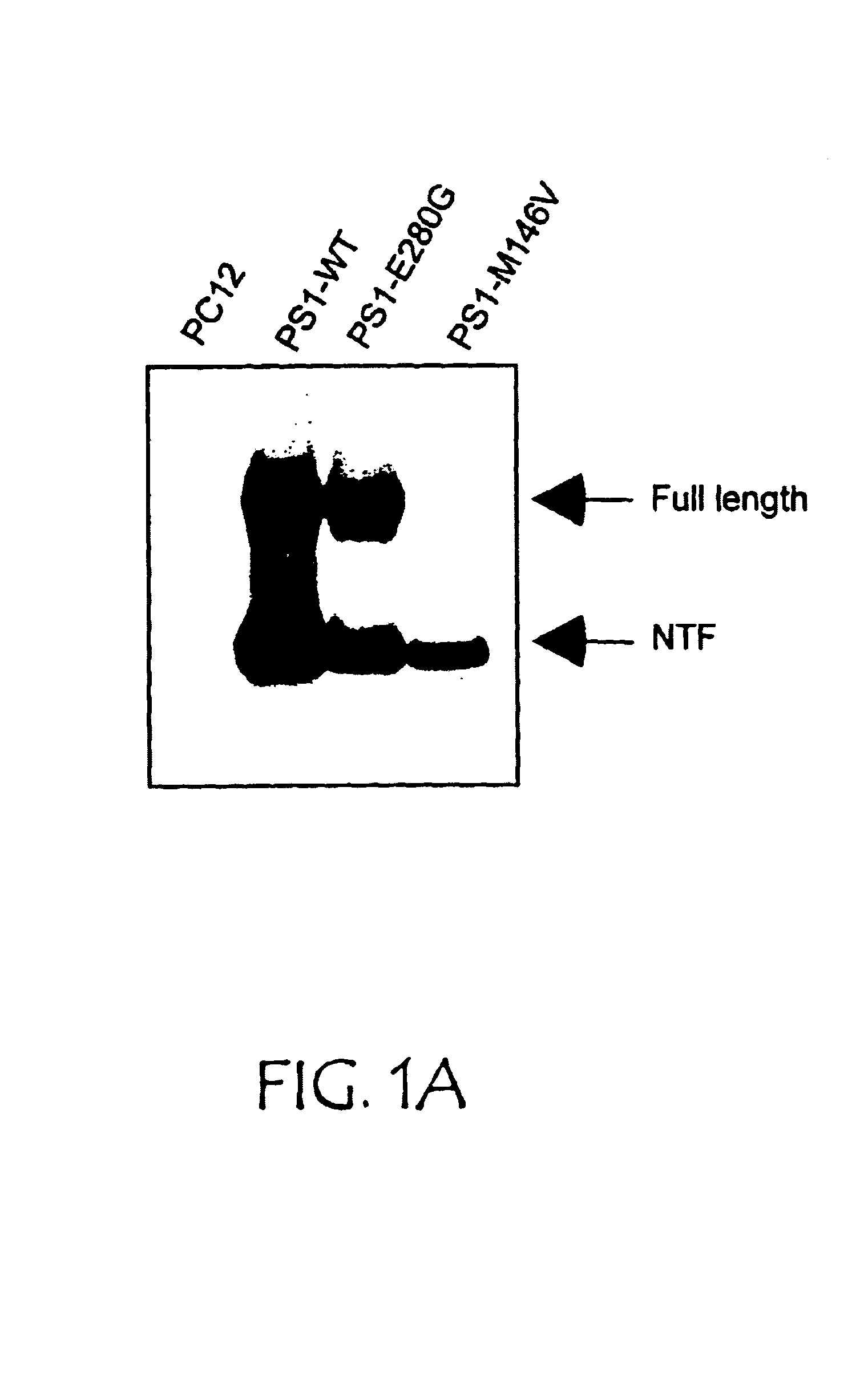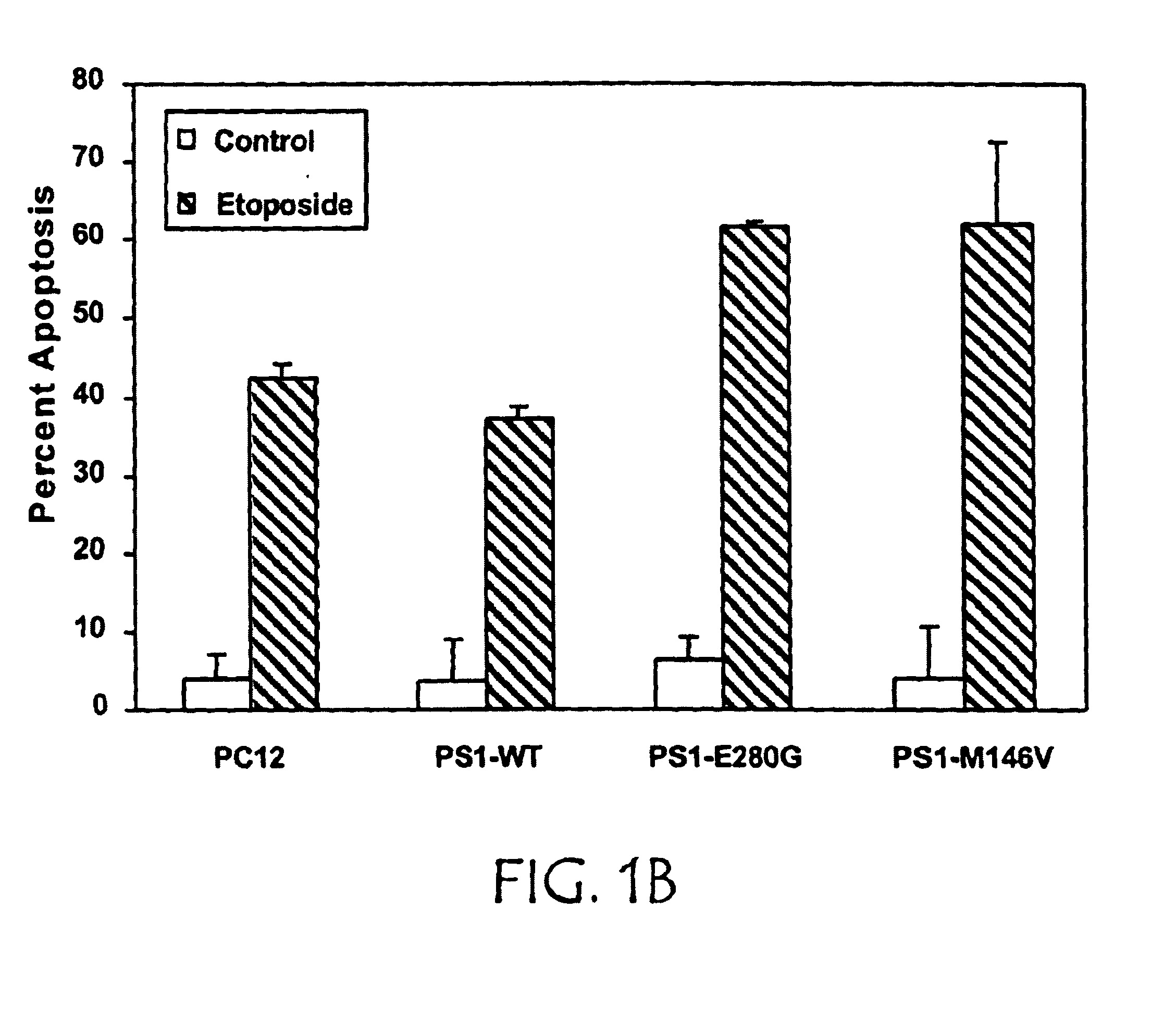Methods for identifying inhibitors of neuronal degeneration
a neuronal degeneration and inhibitor technology, applied in the field of methods and means for identifying inhibitors of neuronal degeneration, can solve the problems of nuclear translocation, neuronal degeneration, and inability to understand the interaction and relationship of these factors and pathways, and achieve the effect of preventing neuronal degeneration and preventing neuronal degeneration
- Summary
- Abstract
- Description
- Claims
- Application Information
AI Technical Summary
Benefits of technology
Problems solved by technology
Method used
Image
Examples
example 1
[0124]PS1 appears to play a critical role in maintaining cell viability. Rat neuronal PC12 cells were stably transfected with cDNA encoding either wild-type human PS1 (PS1-WT) or PS1 with the M146V or E280G mutations seen in FAD (PS1-FAD). The cDNAs encoding full length WT, M146V, or E280G PS1 were engineered for neuronal expression using the neuronal-specific enolase (Quon et al., Nature, 352:239-241 (1991)). Each construct was co-transfected into PC12 cells with a second plasmid carrying the selectable marker neomycin, using Lipofectamine (Life Sciences Inc.). After transfection, pools were selected from which individual clones were isolated. Clones were assessed for human PS1 expression, as well as NTF / CTF processing by Western blot analysis. Briefly, monoclonal antibody 3.6.1, specific for human PS1, was prepared by immunizing mice with a synthetic peptide spanning residues 309-331 of PS1 and rat anti-human PS1 antibody was obtained from Chemicon. Equal amounts of total cell pro...
example 2
[0131]In order to investigate a possible role for PS1 in NF-κB activation, an NF-κB dependent luciferase reporter gene plasmid (Stratagene) and increasing concentrations of a wild type PS1 (PS1-WT) expression vector were cotransfected into 293HEK cells. The PS1-WT expression construct plasmid was prepared using pcDNA 3.1 (obtained from Invitrogen) into which the entire coding region for human PS1-WT cDNA was inserted using EcoR1 restriction endonucelase to join the 5′ terminus and Kpnl restriction endonuclease to join the 3′ terminus of the PS1-WT sequence. The pcDNA3.1 plasmid utilizes a cytomegalovirus promoter to drive expression of inserted sequences. The NF-κB reporter plasmid was purchased from Stratagene (pNF-uBLuc plasmid #219078-51). 293HEK cells at 80% confluence (˜2×105 cells per well) in 6 well plates were co-transfected with the plasmids using either Lipofectamine Plus (obtained from Gibco BRL) or the calcium phosphate method of DNA transfection. The PS1-WT plasmid at 0...
example 3
[0134]Several steps in the signaling pathways leading to NF-κB activation are known and many merge at the level of the protein kinase NIK (NF-κB-inducing kinase) (Ninomiya-Tsuji et al, Nature 398:252-256 (1999); Ozes et al., Nature 401:82-85 (1999); and Pomerantz and Baltimore, EMBO. J. 18:6694-6704 (1999)). To define the signaling pathways that couple PS1 to NF-κB activation, the ability of dominant-negative forms of NIK (NIK-DN) and IκB-α (IκB-α-DN; the specific inhibitor of NF-κB) to block PS1-induced NF-κB activation was investigated. The inactive NIK mutant (KK429-430AA) and IκBα mutant (S32A, S36A) are known to behave as dominant-negative inhibitors of both TNFα and IL-1-induced NF-κB activation. Subconfluent cultures of 293HEK cells were transiently transfected with 100 ng of the NF-κB-luciferase reporter gene plasmid, 2.5 μg of PS1-WT and increasing amounts (0.5 μg, 1.5 μg and 2.5 μg) of NIK-DN (gift of Dr. Claudius Vincenz, University of Michigan) or increasing amounts (0.0...
PUM
 Login to View More
Login to View More Abstract
Description
Claims
Application Information
 Login to View More
Login to View More - R&D
- Intellectual Property
- Life Sciences
- Materials
- Tech Scout
- Unparalleled Data Quality
- Higher Quality Content
- 60% Fewer Hallucinations
Browse by: Latest US Patents, China's latest patents, Technical Efficacy Thesaurus, Application Domain, Technology Topic, Popular Technical Reports.
© 2025 PatSnap. All rights reserved.Legal|Privacy policy|Modern Slavery Act Transparency Statement|Sitemap|About US| Contact US: help@patsnap.com



